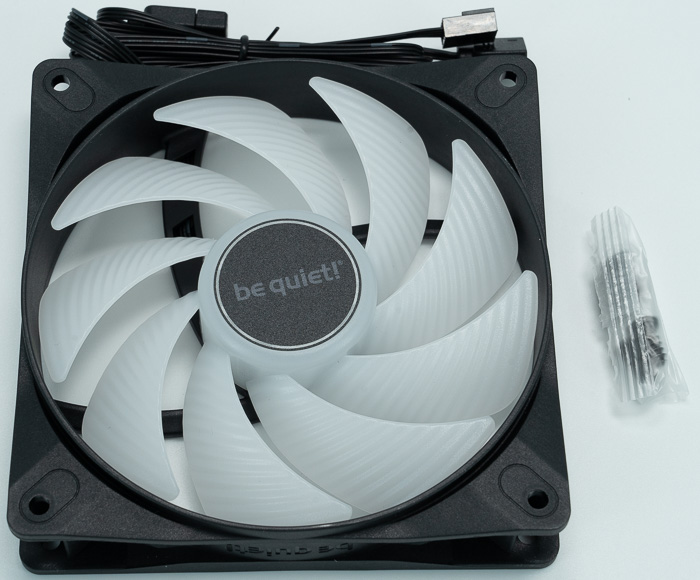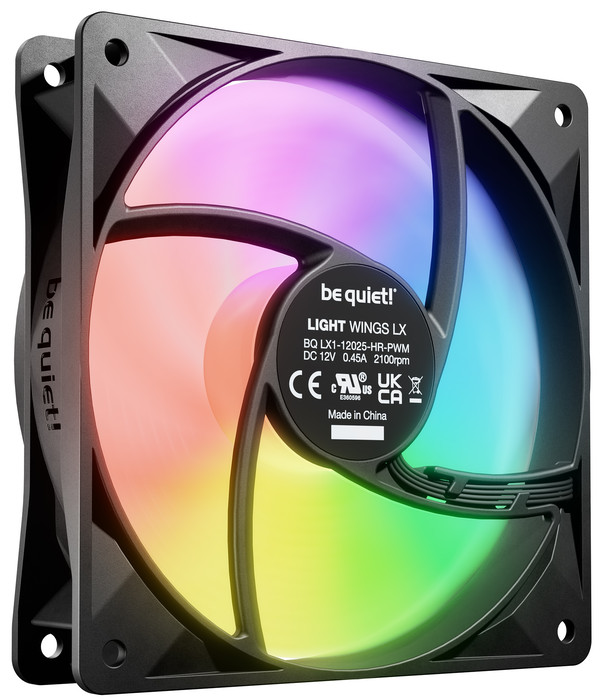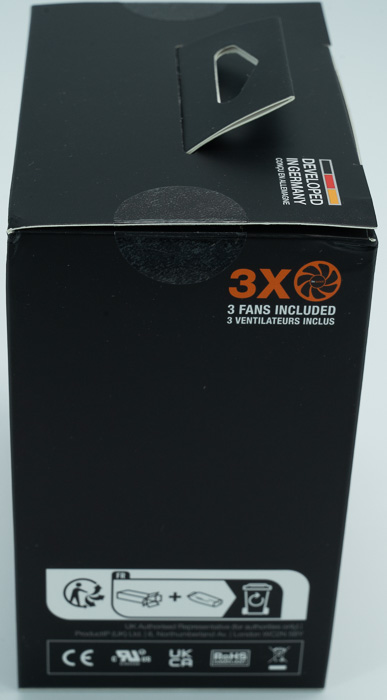be quiet! Light Base 600 LX
3. Retail Package - Light Wings LX
Review Pages
2. Retail Package - Light Base 600 LX
3. Retail Package - Light Wings LX
4. Building up the system - Tests
5. Conclusion
Users can add more Light Wings LX fans, either 120mm or 140mm as well. For our tests, we received several additional Light Wings LX fans, the 120mm PWM High-Speed version.

Light Wings LX embraces the world of ARGB by adopting a bolder style than the original Light Wings with their subtle LED ring. The lighting concept of the Light Wings LX with its 16 LEDs is seamlessly woven into the fan without affecting its performance. Light Wings LX are designed to be integrated into several upcoming be quiet! products with a strong focus on ARGB lighting, such as the Light Loop all-in-one cooler series or the Light Base 600 LX case.
Light Wings LX is available in 12 different SKUs: Light Wings LX Black is available in 140mm or 120mm and PWM or PWM high-speed in both single and triple packs. Light Wings LX White comes in 140mm or 120mm and PWM or PWM high-speed in triple packs only.
The most striking feature of the Light Wings LX fans is the ARBG lighting. 16 LEDs are integrated into the fan hub and distribute the light onto 7 (PWM) or 9 (PWM high-speed) frosted and airflow-optimized fan blades.
The Light Wings LX PWM high-speed models feature a closed-loop motor for consistent speed, that helps keep the rpm steady when they are mounted on a radiator. This feature was first implemented in the Pure Wings 3 high-speed models. Similar to a car’s cruise control, an integrated circuit constantly monitors the current fan speed. The motor will increase its RPM to the target speed when airflow is obstructed. The starting rpm is very low, so with some fan curve tuning, the Light Wings LX can be used in silent systems without a problem. With a maximum of 2,100 rpm (120mm) or 1,800 rpm (140mm), they offer enough buffer in case things get hot. A rifle bearing ensures a lifespan of approximately 60,000 hours.
This technology is not to be confused with the term “closed loop cooler”, a synonym for all-in-one coolers. The closed loop cooler has coolant running in a perpetual loop and typically nothing is added or removed – it is “closed”. In a closed-loop fan controller, the “closed loop” is a feedback loop that transmits the fan speed to a control circuit, where the information is processed to adjust the fan speed to its target. You can compare this feature to a car’s cruise control, where you also set a certain target speed and the cruise control sends signals to the car’s engine to reach it.

Without any advanced physics knowledge, one might assume that a fan always runs at its rated RPM or a percentage of its rated RPM. There are two flaws in this assumption: Firstly, each fan has a variance of usually 5-10% of its maximum RPM. This variance can become higher with age. Secondly, the RPM rating is only valid for freestanding fans with no resistance. If a fan experiences resistance, like a fan grille, heatsink, or radiator, the fan speed is reduced, according to the physical fan laws. These say that airflow and fan speed are proportional, so adding resistance or obstructions to a fan’s airflow reduces the fan’s RPM to balance the relationship between airflow and resistance. Maintaining the fan speed would require additional current.
A mainboard’s PWM fan controller follows an open-loop concept. It sets a certain percentage of the rated maximum speed but does not change its duty cycle based on the actual fan speed – even if most mainboards can read out the tachometer signal from the fan. It is pretty much “fire and forgets”.
The closed-loop fan controller reacts to the tachometer signal, by constantly comparing it to the target speed and adjusting the current and RPM accordingly. This brings several advantages. The user gets stable performance and thermal conditions. On top of that, the older a fan, the higher its speed variance. Since the closed-loop controller always reaches a target speed, the effects of an aging fan can be compensated. For the Light Wings LX PWM high-speed fans, we recommend a minimum RPM of 1,600 under load. This is the range where the closed-loop control kicks in.
- Features
- Illuminated hub and frosted fan blades for unmistakable lighting effects that visually upgrade every PC system
- Multiple colors and modes for an individual look thanks to 16 LEDs
- 9 optimized fan blades with perfect angle for an extraordinary air pressure
- Innovative closed loop motor keeps the rpm no matter the resistance (high-speed versions only)
- ARGB connection cable with daisy chain option
- Low starting rpm for very quiet operation
- Long life rifle bearing gives an operating lifetime of up to 60,000 hours
- 3-year manufacturer’s warranty
| Model | Light Wings LX 120mm PWM high-speed |
| Dimensions (mm) | 120 |
| Color option | Black |
| Lighting | ARGB LED |
| Fan speed at 100% PWM / 12V (rpm) | 2100 |
| Noise level at 100% PWM / 12V (dB(A)) | 30.9 |
| Airflow at 100% PWM / 12V (CFM / m3/h) | 61.8 / 105.1 |
| Air Pressure at 100% PWM / 12V (mm H2O) | 2.51 |
| Noise level at 100% PWM / 12V (dB(A)) | 30.9 |
| Lifespan (h / 25°C) | 60,000 |
| Cable length (mm) | 500 |
| Connector | 4-pin PWM |
| Lighting connector | 5V 3-pin ARGB |
| Daisy-chain compatible | ✓ |
| Dimensions (L x W x H), (mm) | 120 x 120 x 25 |
| Weight incl. fixed cables (g) | 135 |
| Bearing technology | Rifle |
| Motor technology | 4-pole fan motor |
| Price | 18.90 Euro (1 piece) - 54.90 Euro(3 pieces) |
Inside the box of the single fan, you will find only the fan and four mounting screws.

At the back users, will find the product information. There is attached a 4-pin PWM fan cable and an ARGB connector (3 pins), with male and female.


Printed information is also included, in case you need it.

Users can also buy the three pack version, which includes 3x pieces of the Light Wings LX version.




The ARGB effect is very nice to view, especially with a compatible case, like the Light Base 600 LX.


The same fans are included at the Light Loop AIO water cooler from be quiet!

Review Pages
2. Retail Package - Light Base 600 LX
3. Retail Package - Light Wings LX
4. Building up the system - Tests
5. Conclusion





















